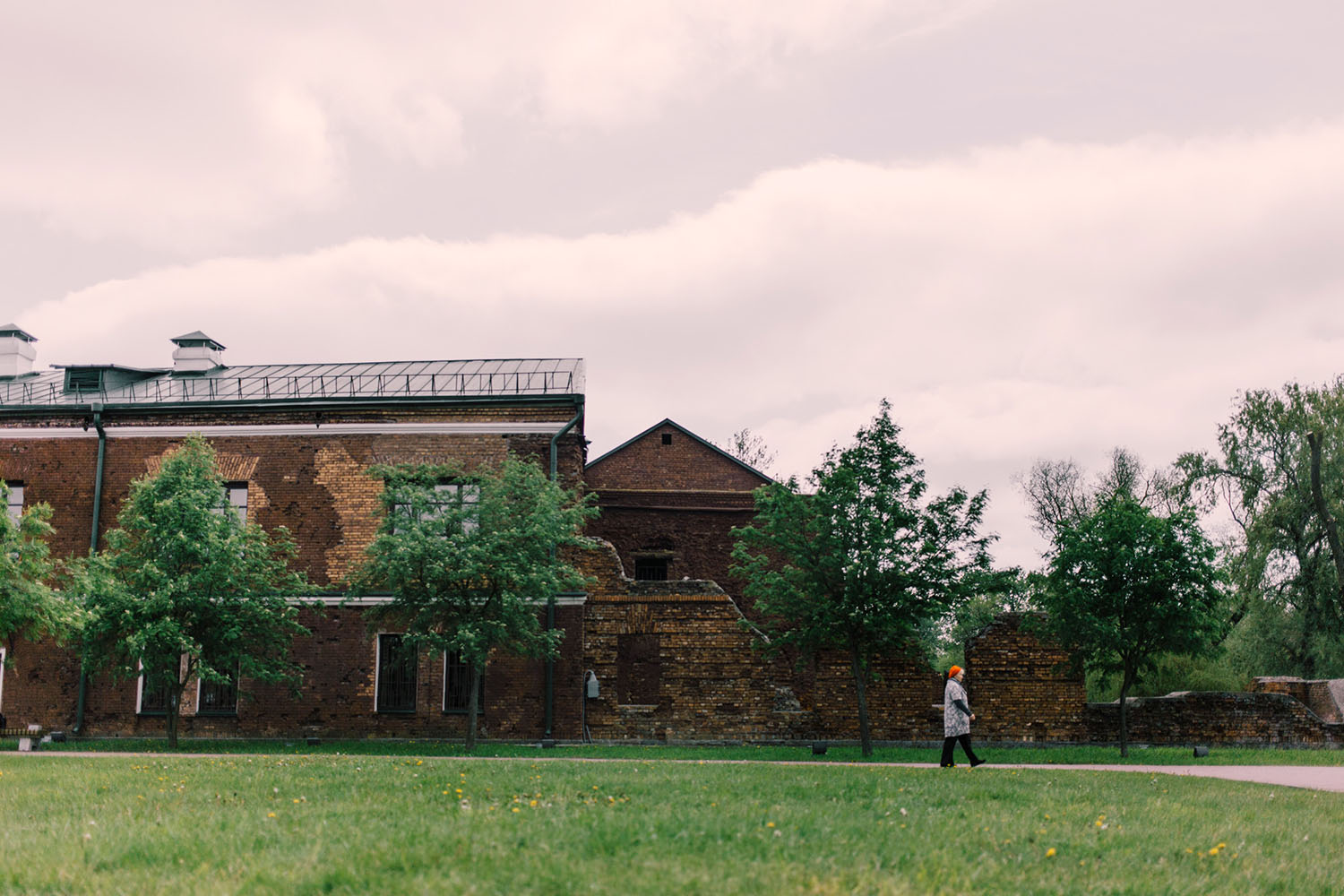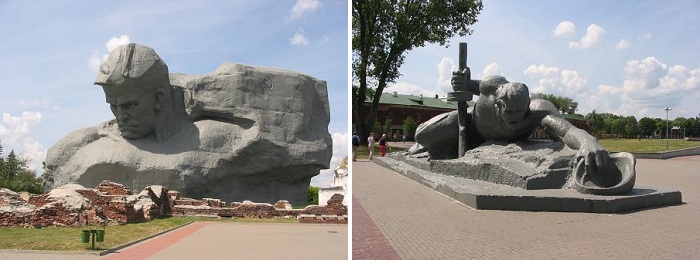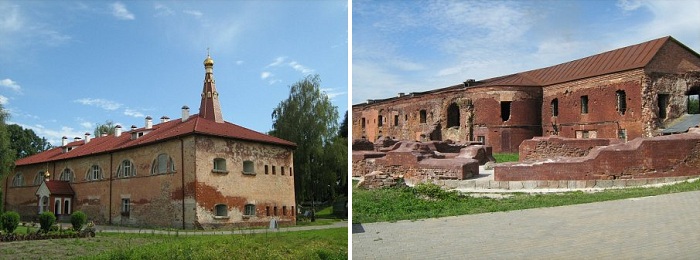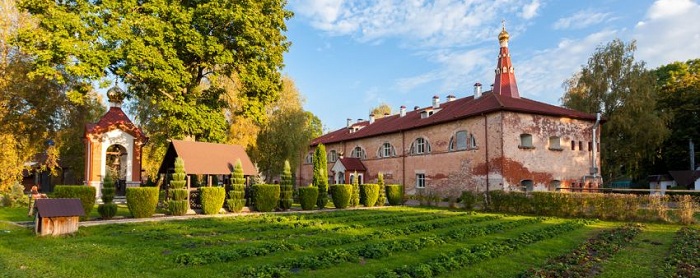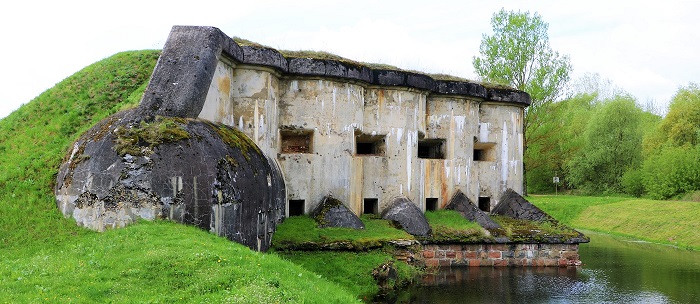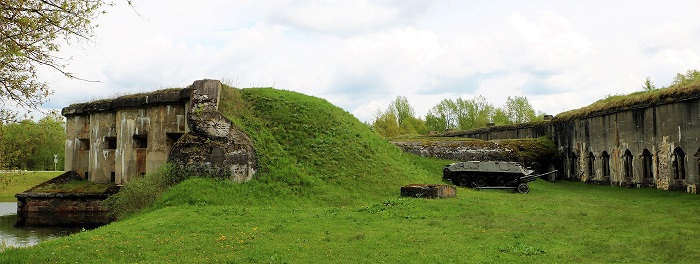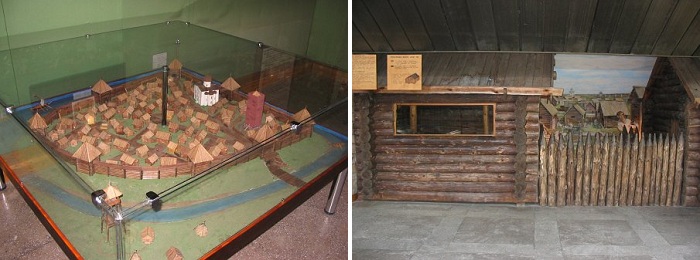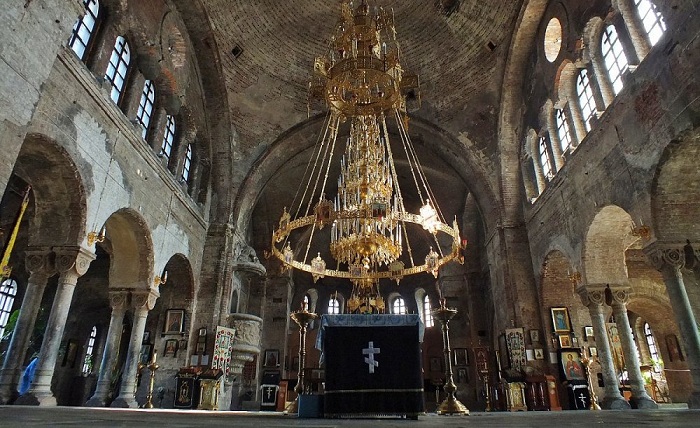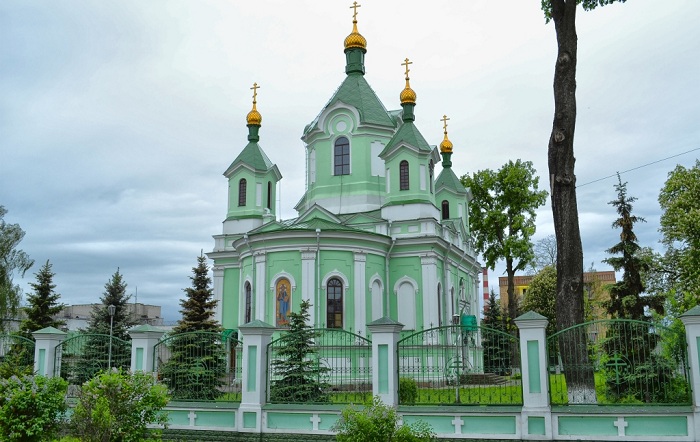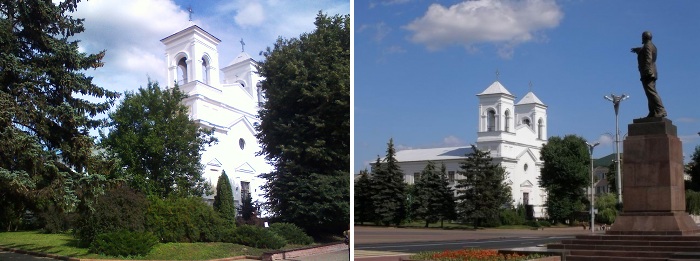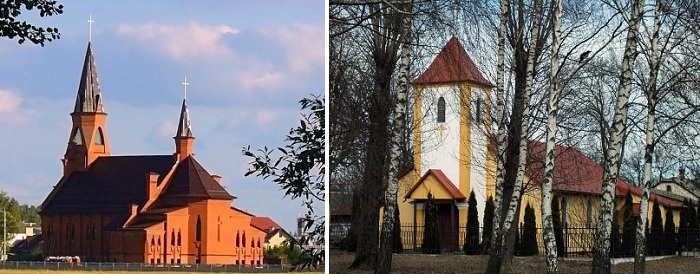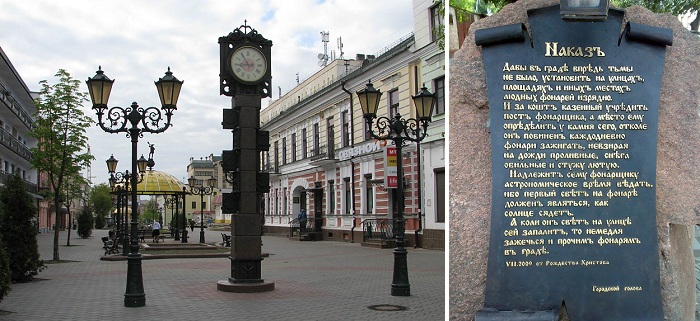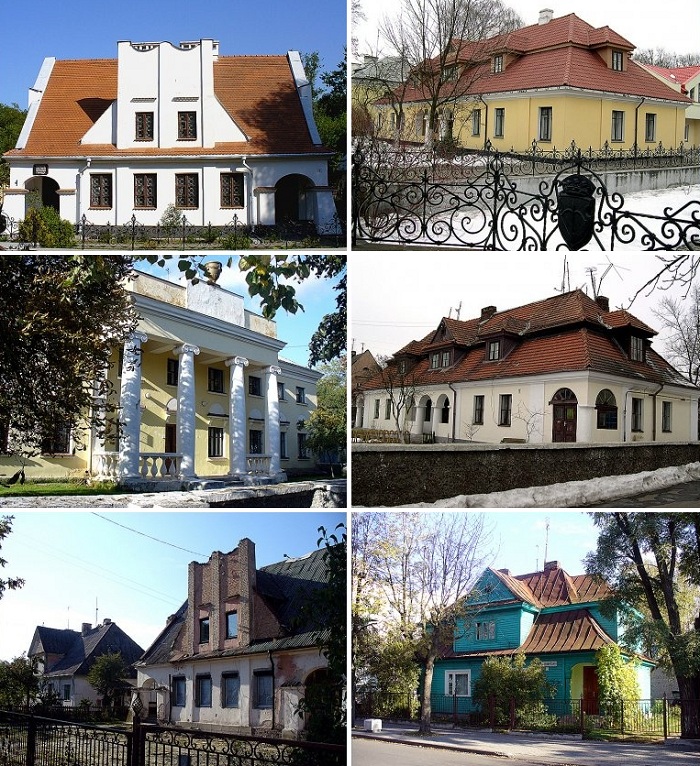Представлено сочинение на английском языке Брестская крепость/ Brest Fortress с переводом на русский язык.
| Brest Fortress | Брестская крепость |
| Brest Fortress is a defensive construction built by Russia in 1836. Its expansion, strengthening and construction continued until 1915. In 1921 it started to belong to Poland. On September 17, 1939 it was seized by the Germans and given back to the USSR on September 22. | Брестская крепость — защитное укрепление, основанное Россией в 1836 году. Её расширение, укрепление и строительство продолжалось до 1915 года. В 1921 году она перешла к Польше. 17 сентября 1939 года была захвачена немцами и уже 22 сентября передана СССР. |
| On June 22, 1941 right after the beginning of the Great Patriotic War, the Germans started fire on the fortress and soon they began to storm it. Since the attack was not expected, the garrison was quickly divided into separate groups, which offered fierce resistance in spite of all their efforts. By June 24, a large group of defenders of the fortress was formed and led by Pyotr Gavrilov. | 22 июня 1941 года, сразу после начала Великой Отечественной войны, немцы открыли огонь по крепости, а вскоре и начали её штурм. Так как атака была неожиданной, то гарнизон был быстро разбит на отдельные группы, которые, несмотря ни на что, оказывали жесточайшее сопротивление. К 24 июня сформировалась большая группа защитников крепости, которой руководил Пётр Гаврилов. |
| It was also difficult to defend the fortress because of the fact that water supply was broken and the defenders suffered from thirst. They managed to hold out until June 29 and after that day the Germans seized almost all the constructions in the fortress. But certain defenders of Brest Fortress fought for a long time after that. For example, there is a famous inscription on one of the walls of the fortress: “I am dying, but I am not giving up. Farewell, Motherland” and it was scribbled on July 20 and the Germans were able to capture the leader Pyotr Gavrilov only on July 23, 1941. About 2 thousand Soviet soldiers were killed in total and about 6800 were taken prisoners. | Сложность в обороне была ещё и тем, что был разбит водопровод и защитники страдали от жажды. Им удалось продержаться до 29 июня, после чего немцы захватили почти все укрепления в крепости. Но отдельные участники обороны Брестской крепости сражались ещё долгое время. Например, известная надпись на стене в крепости: «Я умираю, но не сдаюсь. Прощай, Родина» была нацарапана 20 июля, а командира Петра Гаврилова немцы смогли захватить только 23 июля 1941 года. Всего было убито около 2 тысяч советских солдат, около 6800 попали в плен. |
| The defenders of the fortress did not cause any significant damage to the enemy but their heroism showed that it wouldn’t be a piece of cake for the enemies like it was in other countries. They were able to show the fascists that the Russians would fight for their Motherland till the end. | Защитники крепости не нанесли какого-то значительного урона врагу, но их героизм показал, что такой лёгкой прогулки, как в других странах, не будет. Они смогли показать фашистам, что русский народ будет до последнего драться за свою Родину. |
| Only few people knew about these heroic events in Brest Fortress for a very long time and its heroes who survived were put in Soviet prisons as traitors to the Motherland. And only after the book «Brest Fortress» by Sergei Smirnov was published in 1957 and when Konstantin Simonov supported the research in the mid-60s the whole world found out about this heroic page of the history and soon after that those heroes were released from prison. In 1971, the fortress became a memorial complex, monuments in honor of the feat were set and a museum was opened. | Долгое время о героических событиях в Брестской крепости мало кто знал, а её герои, которые смогли выжить, сидели в советских тюрьмах, как изменники Родины. И только после выхода книги в 1957 году Сергея Смирнова «Брестская крепость», а потом и поддержки его исследования Константином Симоновым, в середине 60-х годов об этой героической странице узнал весь мир и вскоре героев выпустили из тюрем. В 1971 году крепость стала мемориальным комплексом, появились монументы в честь подвига, заработал музей. |
Сочинение на тему «Брестская крепость»на английском языке с переводом на русский язык |
|
Брестская крепость |
|
|
Brest Fortress is a famous historical place in Belarus. It has a title of a “Hero Fortress” because of its heroic defense in the World War II. For a long time, the fortress has been associated with a great feat of people of the USSR, which is reflected in a range of books, poems, songs, and films. |
Брестская крепость – это знаменитое историческое место в Беларуси. Благодаря героической обороне во время Второй мировой войны, она носит звание «крепость-герой». На протяжении долгого времени крепость ассоциируется с великим подвигом народа СССР, что отражено в ряде книг, стихотворений, песен и фильмов. |
|
The fortress has a rich history: its building began in 1833. Brest-Litovsk was one of strategically important cities on the western border of the Russian Empire. In the 18th century, it was decided to build several powerful fortresses there to protect borders from Prussia and Austria. The fortress was opened in 1842; it was one of the best fortifications in Russia and had a complicated structure: a large complex of casemates, artificial islands, ravelins, bridges, and gates. During 19th century, various military units were situated in the fortress. It was ready to take part in the Crimean War. In 1918 the famous Treaty of Brest allowing Russia to get out of the World War I was signed in the fortress. In 1921 it became a part of Poland. |
Крепость имеет богатую историю: её строительство началось в 1833 году. Брест-Литовск был одним из стратегически важных городов на западной границе Российской империи. В XVIII веке было решено возвести там несколько мощных крепостей, чтобы защитить границы от Пруссии и Австрии. Крепость была открыта в 1842 году; она была одним из лучших оборонительных сооружений в России и имела сложную структуру – представляла собой большой комплекс казематов, искусственных островов, равелинов, мостов и ворот. В течение XIX века в крепости размещались различные военные подразделения. Она была готова принять участие в Крымской войне. В 1918 году в крепости был подписан знаменитый Брестский мир, позволивший России выйти из Первой мировой войны. В 1921 году крепость вошла в состав Польши. |
|
During the World War II, Germany attacked Brest Fortress for the first time on September 2, 1939. After a long battle, it became a part of the USSR. Later, on the first day of the Great Patriotic War, Germany started an assault on the fortress. Bloody defense of the fortress continued from June 22 to July 23, 1941; thousands of people dead or were captured. Courage of those soldiers is glorified in a big memorial in Brest Fortress. Now the fortress is open for tourists, there is a museum dedicated to its defense. |
Во Второй мировой войне Германия впервые атаковала Брестскую крепость 2 сентября 1939 года. После долгого боя она перешла к СССР. Позднее, в первый день Великой Отечественной войны, Германия начала штурм крепости. Кровавая оборона крепости продолжалась с 22 июня по 23 июля 1941 года; тысячи людей погибли или попали в плен. Отвага тех солдат увековечена в большом мемориале в Брестской крепости. Сейчас крепость открыта для туристов, там есть музей, посвящённый её обороне. |
- сочинения
The Brest Fortress is strongly associated with the World war II: its beginning, the defense of the fortress, old writings on the walls and the huge monument. In fact the history of this place is much longer: the timeline counts for at least a thousand years from ancient times till two world wars. Here you can walk around huge green parks or interactive museums. Check out our route to dive deep into history.
How to come the Fortress
You already know how to come to Brest from our detailed guide. The address of the fortress is 60, vulica Hierojaŭ Abarony Bresckaj krepasci. There’s no convenient public transport, and the signs show up just at the nearest to the fortress road crossing. That’s why we recommend walking. The route is pretty pleasant: you can go either by Hohala boulevard or Masherava avenue.
By the way, before visiting the fortress you can drop by the local Railway Museum (2. Masherava avenue) to see retro-trains. The museum is located close to the fortress, the ticket costs about € 1.
The Brest Fortress stands on four islands: the central part is the Citadel, which is surrounded by Kobrynskaje (in the north), Valynskaje (in the south) and Ciarespalskaje (in the west) islands-fortifications. The central island appeared when the river Zachodni Buh and branches of river Muchaviec merged. Right here there was the ancient town of Biarescie, which was later renamed into Brest-Litoŭsk. The remaining three islands are formed by Muchaviec and artificial moats. Originally there were eight fortress gates, but only five survived till today.

The construction of the Fortress began in 1833 upon the project by Carl Opperman on the territory of the old town. It was finished by 1844. All the inhabitants of the town had to move 2 km to the east, right where the modern city of Brest is located today. By the beginning of the 20th century, the fortress was renovated a couple of times.
The fortress wasn’t much destroyed during the WWI. The Treaty of Brest-Litoŭsk was signed here: Soviet Russia ended its participation in the war and lost some of its territory. In 1920-1939 the Polish military reservations were located in the fortress, and on the second day of WWII (September 2, 1939) German planes began to throw bombs on it. On September 22 Brest and the fortress was officially given to the USSR, and in 1941 the war for the Fortress began again.
In 1956 it was decided to create the museum. It was encouraged by Sergei Smirnov’s works: he collected stories about the first days of the war and the people whose destiny was tied strongly with this place. In 1965 the fortress received the title “Hero-Fortress”, and in 1971 the memorial complex was opened.

The main entrance to the fortress is a huge concrete five-pointed star. Stay there for a couple of minutes: you’ll hear that very announcement about the beginning of the war. It impresses you greatly even if it’s not your first visit. Walk through the parkway and get to the central island – the Citadel.
The White Palace
Just ruins remain from the White Palace. There was a wooden church back in the 17th century, in the 18th the stone building of military assembly was constructed. In the beginning of the 20th century there were a restaurant, billiards, a dance hall and a library in that building. In 1918 the Treaty of Brest was signed here.
The Sculptural Composition “Thirst”
The iconic monument commemorates the dramatic first days of the war, when the waterline was knocked out of action and the route to the river was constantly under fire.
Ceremonial Square
A huge square with memorial stones and the names of the fallen engraved on it, the 100 m high bayonet-obelisk, the eternal flame and the main monument (which is unofficially, but commonly called “The Courage”). Solemn and sorrowful place that reminds us that war should only stay in museums.
The Engineering Administration
Before the construction of the fortress began, there had been a baroque Jesuit College here. In 1836 it was transformed into the Engineering Administration, some of its rooms were used as the emperor’s family apartment when they visited the fortress. During the WWII the building was ruined.
Art Museum
The Brest Fortress is not just about the war. You can visit the museum to see some art works by local artists. Besides paintings, there is also a miniature of ancient Brest. The ticket costs € 1.
The Museum of Brest Hero-Fortress
In the first two rooms of the museum you’ll learn the history of the WWI and the inter-war period. The following rooms thoroughly present the story of the military action: photos, documents, stuff. There’s a collection of the 18-20th centuries weapons in the last room. The ticket costs € 1.5-2.5 (and the admission is free on the last Friday of every month), the guided tour will cost you about € 5-9. The museum is open from 9 a.m. till 6 p.m. You can also book themed tours around the whole complex.
The Museum of War is the Territory of Peace
Another museum is situated in the south-eastern barracks of the Citadel. It was opened in 2014 and focuses on the personal stories of people who lived though the war. The stories are told in documents, photos, media and audio installations. The ticket costs € 1-2, opening hours are from 10 a.m. till 7 p.m. (Tuesday is a day-off). All the contact information of both museums is here.
St. Nicholas Garrison Church
The Byzantinesque orthodox church was built in 1876. In 1924, while those territories belonged to Poland, it was transformed into a catholic church (some elements still may be seen inside), since 1941 there was a garrison club there and just in 1999 the building was turned into a church again.
Kholmskija Gates
Beautiful gates with scars from bullets are the symbol of the fortress and the city in general. They used to be the main entrance to the city. The gates were named after the Polish town of Chełm and survived through both wars. They were also called Hospital Gates, because they led to the island where the hospital was located. There’s a bridge, which will bring you to Valynskaje fortification, behind the gates.

The Archeological Museum “Biarescie”
Let’s dive into the deepest layer of local history. It is the only museum of medieval eastern European town in the world, which is situated exactly where the ancient town of Biarescie was situated. 13th century houses, roads and furnances have been preserved there. You can see all this from the above. Today the museum is under reconstruction, but as soon as it’s finished, we strongly recommend visiting this medieval city.
Bernardine Monastery Ruins
In the 17th century there was a Bernardine monastery. In 1842 the building became a military school, and then a hospital. Today it is just the foundation, basement and ruins of two floors with trees growing inside.
The St. Mary Nativity Orthodox Convent
This convent has been rebuilt, but is working today. The convent was here already in the 17th century, but it was demolished during the construction of the fortress. The new building of the convent is preserved from 1854. Right behind the convent there are Southern Gates leading back to the city.

The ruins of a few barracks remained on the bordering island. If you want to visit it, you have to apply in advance (10 days before) and bring your passport and the official permission to enter the borderland. Tourists are allowed to stay at the island only with guided groups (and a border guard). If it doesn’t sound appealing enough, you can just see how the rivers Buh and Muchaviec run one into another: you’ll notice that they have different colors. There also was a wire bridge to the island: it was the biggest wire bridge in the Russian Empire. Nowadays we can see just some elements of its foundation.

Northern Island is not as popular as the Central one. There are fewer people and it’s very green (it actually looks like a gigantic park). Of course, there are some military fortifications. Have a look at the western and eastern forts and the bastion, walk along the earth wall or just wander around among fields and trees. Local legends tell stories of a mysterious half-ruined monument (which is believed to be a sculpture of Polish pioneers installed in the 1930s), the boulevard with the remains of red pavement (red from the blood of the soldiers who died here, according to the story) and a small round lake (appeared in a bomb crater – again, according to the local mythology).
Besides the fortress, there are two rings of the forts in about 6-10 km from it (some of them are on the Polish territory). Most of them are ruined or almost ruined, but some of them were turned into museums. For example, The 5th Fort (99, vulica Staradarožnaja).
Food & Souvenirs
You can buy souvenirs and have a pancake in front of the entrance to the complex, but these shops are only open during summer. You can also look for souvenirs in the Museum of Brest Hero-Fortress, in the building near Kholmskija Gates and in the South-eastern barracks (next to the monument “Thirst”). Head for the café “Citadel” on the northern island to have dinner. It’s located in the historical building that used to be casemates of an artillery squadron.
Info
The official website of the memorial complex – brest-fortress.by.
If you want to explore the huge territory of the fortress on your own, make sure to download the free app with information and historical photos of each spot and four themed routes. The app is available in English.
Photos by palasatka
Brest Fortress (Belarusian: Брэсцкая крэпасць, Bresckaja krepasć; Polish: Twierdza brzeska, Lithuanian: Bresto tvirtovė, Russian: Брестская крепость), formerly known as Brest-Litoŭsk Fortress, is a 19th-century fortress in Brest, Belarus. In 1965, the title «Hero Fortress» was given to the fortress to commemorate the defence of the frontier stronghold during the first week of the Operation Barbarossa when Axis forces invaded the Soviet Union on June 22, 1941. The title «Hero Fortress» corresponds to the title «Hero City» that the Presidium of the Supreme Soviet of the Soviet Union awarded to twelve Soviet cities.
The fortress in the 1830s
DescriptionEdit
The Brest fortress has sustained its original outline of a star shaped fortification since its construction in the early 19th century. The Citadel, the core of the fortress, was on the central island formed by the Bug River and the two branches of the Mukhavets River. The island was skirted by a ring of a two-storied barrack with 4 semi-towers. The 1.8 km long barrack comprised 500 rooms to accommodate 12,000 soldiers within thick walls built from super strong red bricks. Originally there were 4 gates to enter the Citadel. Today only Kholm Gate and Terespol Gate can be seen; most of the barrack lies in ruins.
The Citadel was surrounded by 3 fortifications as bridgeheads, that were made up by branches of the Mukhavets River and moats (ditches), fortified by earthworks 10 m high with redbrick casemates inside. The 3 fortifications were named after two towns: Russian name for the city of Kobryn in Belarus, Terespol in Poland and Volyn, a historic region of Volhynia majorly located in Ukraine. The Kobrin Fortification was the biggest in the fortress, located in the northeastern part, shaped like a horseshoe, featured 4 fortification curtains, 3 detached ravelins and a lunette in the western part, East Fort and West Fort. The Terespol Fortification was the western bridgehead, featuring 4 detached lunettes. The Volyn Fortification was the southeastern bridgehead, featuring 2 fortification curtains with 2 detached ravelins.[1]
HistoryEdit
ConstructionEdit
The construction of the Imperial Russian fortress, in place of the old Ducal Lithuanian Brest Castle, started in 1833 based on a draft of the Russian military engineer Karl Opperman.
WWIEdit
After the fall of the forts at Kaunas and Novogeorgievsk, the Russians abandoned Brest fortress, carrying away most of their stockpiled munitions. The Germans entered the fort on August 26, 1915. In 1918, the fort was the location of the signing of the Treaty of Brest-Litovsk, which made peace between USSR and the Central Powers.
During WWIIEdit
Polish Defense of Brest FortressEdit
The Battle of Brześć Litewski (also known as the Siege of Brześć, Battle of Brest-Litovsk or simply Battle of Brześć) was a World War II battle involving German and Polish forces that took place between 14 and 17 September 1939, near the town of Brześć Litewski (now Brest, Belarus). After three days of heavy fights for the stronghold in the town of Brześć, the Germans captured the fortress and the Poles withdrew.
On 14 September 77 German tanks of the 2nd Battalion of the 8th Panzer Regiment, part of 10th Panzer Division, reached the area of Brześć and attempted to capture the fortress on the run. The probe attack was repelled by Polish infantry and the 113th company of light tanks, consisting of 12 obsolete Renault FT tanks. All the Polish tanks were destroyed, but the German forces were forced to retreat towards their initial positions. Polish armoured train number 53 (PP53), which made a reconnaissance advance to Wysokie Litewskie, was attacked by a scout patrol from the 10th Panzer Division. The crew from the train opened fire with artillery. Several other skirmishes were fought, but were largely inconclusive.
Later that day the German artillery arrived and started bombardment of both the fortress and the town. Heavy street fighting ensued. At dawn approximately half of the town was in German hands, the other half being defended by Polish infantry. Polish anti-tank weapons, artillery and AA guns were very scarce and were unable provide enough support for the infantry.[citation needed] The following day Polish defenders withdrew from the town, but heavy casualties on both sides prevented the German units from continuing the attacks on the fortress. Instead, it was constantly shelled with artillery and bombed by the Luftwaffe.
The main assault finally started in the early morning of 16 September. The defenders had plenty of small arms ammunition and light arms thanks to the munitions depot in the fortress, but had almost no anti-tank weapons and insufficient artillery cover.
Although the German infantry was repelled and the assault of German tanks was stopped by two FT tanks sealing the northern gate of the fortress, by nightfall it became apparent that the German pressure made the situation very grave. Despite heavy losses, the German 20th Motorized Division and 10th Armored Division captured the northern part of the citadel. Meanwhile, the combined 3rd Armored Division and 2nd Armored Division comprising the XXIInd Armored Corps entered the area. The Poles were unable to resupply and the casualties rose to almost 40%.
At dawn General Plisowski ordered part of the Polish forces to retreat from the easternmost fortifications and regroup to the other side of the river and southwards. The evacuation was completed by early morning, 17 September when the last unit crossing the bridge blew it up to hinder the Germans.
After its capture by the Germans, it was soon passed on to the USSR per the German–Soviet Frontier Treaty.
Soviet Defense of Brest FortressEdit
Copy of the inscription found inside the citadel: «I’m dying, but I won’t surrender! Farewell Motherland. 20.VII.41» exhibited in the Museum of the defense of the Brest fortress
At 04:15 (Moscow time) June 22, 1941, the German Wehrmacht attacked the Brest fortress with no warning. The attack started with an artillery barrage, including 60cm mortars of the second battery of the Heavy Artillery Battalion 833 Nr. III («Thor») and Nr. IV («Odin»).[2] The defenders were taken by surprise and initially failed to form a solid front. By 09:00 that day, the fortress was completely surrounded. The ensuing battle of Brest Fortress lasted for eight days, during which about two hundred soldiers and officers defending the castle died; German casualties amounted to 430 soldiers and officers.[3][4]
The last defended part in the fortress was taken by June 29. All in all about 6,800 Soviet soldiers and commanders were captured.
According to Soviet propaganda, the battle lasted until 20 July, with no one surrendering to the Germans. This narrative became a testament to the resilience and courage of Red Army and Soviet people.[5] A few Soviet soldiers did indeed hold out inside pockets of the fortress until as late as 23 July.[6]
The last Soviet platoon fighting in the fortress was led by Pyotr Gavrilov, a major commanding the 44th Motor Rifle Regiment of the 42nd Rifle Division. He surrendered with his remaining survivors on 23 July, 1941 after holding out for 31 days and was held captive in Hammelburg and Ravensbrück concentration camps until his release after the end of the war in May 1945. He was awarded the Order of Lenin and the title Hero of the Soviet Union in 1957.[7][8]
August 1941Edit
During a journey to different parts of the Eastern front, Hitler and Mussolini visited the fortress on August 26, 1941. Strong security measures were in place.
LegacyEdit
War Memorial ComplexEdit
In the late 1960s, the construction of the war memorial complex «Brest Hero Fortress» was started. The complex was opened on September 25, 1971.[9] The memorial complex is a national place of grief and pride, a popular tourist attraction. It comprises the barracks, gunpowder bunkers, forts and other fortifications, the museum of the defence, located on the site of the old fortress, along with the new monumental structures: the Main Entrance, the Obelisk, the Main Monument, the sculpture «Thirst».
The centre of the complex is officially known as Ceremonial Square.[10]
World Heritage statusEdit
This site was added to the UNESCO World Heritage Tentative List on January 30, 2004, in the Cultural category.[11] Preservation and development is being carried out by the Brest Fortress Development Foundation.[12][13]
Symbol of Brest cityEdit
The Brest Fortress is used as a symbol of the Belarusian city of Brest.
Brest in literature and popular cultureEdit
- Fortress of War (Russian: Брестская крепость), a 2010 Russian-Belarusian film
- Weary Sun Triumph Brest Fortress (Russian: Утомленное солнце Триумф Брестской крепости), a 2010 alternative history by Valeriy Belousov
- I, a Russian soldier (Russian: Я — русский солдат), a 1995 movie based on the novel His Name is Not in the List
- His Name is Not in the List (Russian: В списках не значился) novel by Boris Vasilyev)
- 1941: Brest Fortress. Kazakhstan. (Russian: 1941: Брестская крепость: Казахстан) book by Kazakh professor Akhmetova, Laila about the defenders of Brest Fortress from Kazakhstan (2016)
See alsoEdit
- Defense of Brest Fortress (1941)
- Battle of Brześć Litewski (1939)
- List of Jesuit sites
ReferencesEdit
- ^ Суворов А.М. «Брестская крепость на ветрах истории», Brest, 2004 (text in Russian) ISBN 985-90040-1-3
- ^ «Мортира КАРЛ». Archived from the original on 2017-07-06. Retrieved 2017-05-11.
- ^ Christian Ganzer: German and Soviet Losses as an Indicator of the Length and Intensity of the Battle for the Brest Fortress (1941). In: The Journal of Slavic Military Studies, Volume 27, Issue 3, pp. 449–466, here: p. 463.
- ^ Christian Ganzer: German and Soviet Losses as an Indicator of the Length and Intensity of the Battle for the Brest Fortress (1941). In: The Journal of Slavic Military Studies, Volume 27, Issue 3, pp. 449–466, here: p. 458.
- ^ Christian Ganzer: Soviet Prisoners of war in Soviet and post-Soviet commemorative culture. The Brest fortress: a case study. In: Frédéric Bonnesoeur et al. (eds.): Occupation — Annihilation — Forced Labour. Papers from the 20th Workshop on the History and Memory of National Socialist Concentration Camps. Berlin 2017, pp. 193-209.
- ^ «Брестская крепость. — М.: Раритет, 2000. — 406 с. (text in Russian)». Archived from the original on 2021-09-09. Retrieved 2021-09-09. ISBN 5-85735-119-7
- ^ «Heroes of Soviet Union, Гаврилов Пётр Михайлович (text in Russian)». Archived from the original on 2021-09-09. Retrieved 2021-09-09.
- ^ Henry Sakaida, Heroes of the Soviet Union 1941–45, Osprey Publishing, 2004, ISBN 1-84176-769-7, Google Print, p.48
- ^ «the official website of the war memorial». Archived from the original on 2017-07-03. Retrieved 2016-05-15.
- ^ https://www.kathmanduandbeyond.com/visiting-brest-fortress-belarus/
- ^ UNESCO Tentative List for Belarus
- ^ Brest Heritage
- ^ Brest Fortress Development Foundation to receive US Grant
External linksEdit
- Official homepage of the Brest Hero-Fortress Memorial
- Brest Fortress on official website of the Republic of Belarus
- UNESCO publication about the Brest Fortress
- Aerial photo from June, 1940
- Jurkau kutoczak — Юркаў куточак — Yury’s Corner. Фартэцыя ў Берасьці 1836-1842 гг.
- Photo 1024×768
- Main fortress 52°04′59″N 23°39′15″E / 52.082961°N 23.654251°E
- External forts
- 52°02′51″N 23°40′25″E / 52.047516°N 23.673477°E
- 52°02′46″N 23°37′07″E / 52.046090°N 23.618588°E
- 52°04′49″N 23°35′45″E / 52.080172°N 23.595747°E
- 52°03′52″N 23°32′58″E / 52.064457°N 23.549516°E
- 52°02′36″N 23°33′15″E / 52.043306°N 23.554097°E
- 52°01′10″N 23°36′14″E / 52.019365°N 23.603868°E
Coordinates: 52°04′55″N 23°39′29″E / 52.082°N 23.658°E
Brest — is a city, the administrative center of the Brest region and Brest district of Belarus. The city of Brest has a special place among the cultural and historical heritage of Belarus. In Brest, a lot of attractions. The city of Brest and its attractions is not about one single site. Our site was created to describe the less well-known places, it is intended to open the readers new and interesting sights, city and places, which they previously could not have known. Brest, of course, does not apply to such places, know about it all. Tourists love it and actively attend. Therefore, just to mention the sights of Brest.
The main attraction of the city of Brest is Brest Fortress. Brest Fortress was originally built in 1836-42 years. It was built in the historic center of the city of Brest, and for its construction was demolished and rebuilt all the historical buildings of the city of Brest of 16-18 centuries. Brest Fortress being completed and renovated many times, and as a result represents a huge multi-level fortification complex. By the spring of 1915 the Brest Fortress was one of the strongest fortresses of all Europe. However, during the First World War the Brest Fortress had no significant impact on the course of events, since at the last moment it was decided to leave it without a fight, and to take out valuable property. During the organized retreat of Russian troops, the fortress was also partially blown up. Nevertheless, it is here that was signed «Treaty of Brest-Litovsk», which marked Russia’s withdrawal from the First World War. In the interwar period, the fortress was used by Poland as a barracks, a military depot and a political prison.
In September 1939, at the beginning of the Second World War, then the Polish army defending the Brest Fortress (as well as later the Soviet garrison of the fortress) showed heroism and steadfastness, and within three days from September 14 to September 17 reflected in total 7 attacks of the enemy, whose strengths far exceeded the strength of defenders of the fortress. At the same time, the Germans suffered significant damage. After that the Polish army organized retreated to the south, and the fortress was partially blown up. Then, on September 22, the city of Brest along with the fortress was transferred by the Germans under the control of the Red Army.
On the night of June 22, 1941, the Brest Fortress was one of the first to take on an enemy strike by German troops. This was the beginning of the Great Patriotic War on the territory of modern Belarus. The further heroic defense of the Brest Fortress, although it had no significant effect on the general course of the war, however became one of the largest military feats for the entire Great Patriotic War. After the war, the Brest Fortress was awarded the title «Hero-Fortress», and a large memorial was established on the ruins of the fortress.
Now the memorial complex «Brest Fortress — Hero» has several huge sites, many monuments smaller stele, museum, the former garrison church (of which below), an exhibition of military equipment of World War II, surviving fragments of buildings, as well as other defenses of the fortress. There are also other tourist facilities, such as a restaurant and souvenir shops. Today the Brest Fortress is one of the most visited tourist attractions of Belarus. Every day many travelers come here, including from many foreign countries.
On the territory of the Brest fortress is also located a female Orthodox monastery. This monastery founded in our time in one of the best preserved of the former buildings of the Brest fortress, which previously housed the regimental school.
The Brest Fortress also includes its «Fifth Fort» — a unique historical defensive structure (a separate article here). The fifth fort of the Brest Fortress was built in the 1880s and was finally completed in 1888. Later, in the period from 1908 to 1914, a significant reconstruction of the fifth fort of the Brest Fortress was carried out. The fort was one of the defensive objects of the Brest Fortress of the second line. The fifth fort is located four kilometers south of the main complex of defensive structures of the Brest Fortress on one of the outskirts of the modern city of Brest.
In the fifth fort of the Brest Fortress, there is a museum of fortification and armament history. This museum is a branch of the memorial complex «Brest Fortress», but does not enter directly into this memorial complex. On the territory of the fifth fort of the Brest Fortress there is an exhibition of military equipment from the times of the Second World War. One of the most remarkable features of this museum is that here, for inspection, absolutely all the corners of all fort facilities are open, which are obviously in a neat and tidy state. Between all facilities of the fort, visitors are allowed to move including underground corridors.
Visiting Brest Fortress soon as possible and you need to pay attention to the other most valuable tourist attraction of Brest — a unique archaeological museum «Berestye». This museum is also located in the territory of the Brest fortress, a little away from the main memorial complex. This museum and the fortress of Brest is a single tourist complex. This is due to the fact that, as already mentioned, the Brest Fortress is located directly in the center of Brest. After the war, during excavations in the ancient city of Brest fortress was found. It was finally unearthed and then over this mound have built a special building, which performs the function of protection of ancient sites and maintain the ideal conditions for their preservation. This building became the museum, which is now open to the public. This museum is absolutely unique for Belarus. On the territory of Belarus are not present anything like it.
The exposition and funds «Berestye» museum stored a total of 43 thousand exhibits. At the heart of the museum — the remains of the ancient wooden buildings of Brest the 13th century, as well as entire streets paved with wood. Wooden buildings and parts of the bridge have been preserved specially developed synthetic substances.
Also, as already mentioned, in the territory of the Brest Fortress has the former garrison church of St. Nicholas, originally built in 1876. The church operates today. This temple is a very valuable monument of architecture. Outside the temple has been completely restored, but the interior of the church was not restored since the war (it was held only preservation). The walls still bear the traces of the results of various projectiles. A visit to this temple is very impressive.
Finally, it is worth mentioning also about another attractions of the city of Brest is located in Brest Fortress, namely the ruins of the former convent and church of the Bernardine. Originally, the monastery was built in the second half of the 18th century. This is one of the few buildings of the historic center of the old Brest, which was not completely destroyed (or rebuilt to the needs of the fortress) in the construction of the citadel. But it is still today the only building in the fortress, which continues to deteriorate and is in a derelict state.
We now turn to the description of sights of the city of Brest, located outside of the fortress. One of these attractions is the Orthodox church of St. Nicholas, built in 1906. This church is also called «fraternal», to distinguish it from St. Nicholas Church, located in the fortress.
Another Orthodox church — Cathedral of St. Simeon, built in 1868, is also an important attraction of Brest and valuable architectural monument. There is in the city of Brest and a few more contemporary Orthodox temples.
Another important attraction of Brest is the Catholic church of the Elevation of the Holy Cross, built here in 1856. This church is located on the central square. It is remarkable to note an interesting ideological rendering of the former Soviet authorities of Brest: Lenin statue, installed in the same area of the city of Brest, pointing the way, shows strictly to church. There is at Brest, and several other Catholic churches, including more contemporary temples.
Another very interesting attraction of the city of Brest is a stunning museum of railway equipment. This museum contains a lot of locomotives and other railway equipment. A very positive feature of this museum is that visitors to the museum is allowed access to the interior of all the exhibits. You can examine how the driver’s cab and the engine compartment of most locomotives. As it is also possible to climb in and out. Allowed and unlimited photos with the exhibits. Museum of railway equipment in Brest is a very interesting and unique museum in Belarus it has no analogues.
In addition to these, in Brest there are so many different historical buildings, which can be attributed to the historical city building. Most of them belong to the second half of the 19th century or early 20th century. Earlier building, as mentioned, have been rearranged or destroyed during the construction of the fortress. In Brest, there is a whole pedestrianized street surrounded by interesting historical buildings. Making the most of the street (benches, lampposts and so on) as the style of old, and in the middle of the street set beautiful monument «Millennium of Brest.» Special mention also deserves the central station of the city of Brest, built in 1886. Otherwise, the historical buildings of the city of Brest is a former residential (houses) and administration (courts, hospitals, schools, gymnasiums, banks, post office, etc.) buildings.
In addition, it is obvious that in such a large city as Brest, tourists can always find everything they may need (ATMs, hotels, shopping centers and so on). For this reason, and in view of the important and unique attractions for the whole of Belarus (fortress, Archaeological Museum, Museum of railway equipment), the city of Brest was the use of the tourists very popular. People come here not only to travelers from all over Belarus, but also from a very wide range of foreign countries. And indeed the city of Brest is one of the best holiday destinations for tourists and travelers in Belarus.
Sketches of Napoleon Orda, Brest:
Brest at the old photos:
В топике Брест я рассказываю о своем родном городе. Брест впервые упоминается в летописях в 1019 году и, в течение истории, название города было изменено несколько раз. В Бресте есть много музеев, два театра, один каток, два университета, пять гимназий и один лицей. Брестская крепость является главной достопримечательностью города: ее защитники держали длительную оборону против немцев в 1941 году и, в результате тяжелых боев, крепость была разрушена. После войны остатки крепости были превращены в грандиозный Мемориал ее защитникам. Сейчас Брест – крупный экономический центр, поскольку он расположен на границе Беларуси и Польши.
Brest is a beautiful old city on the west of Belarus. It is a city and administrative center of the Brest region of the Republic of Belarus. The city is located on the right bank of the Western Boog River. Brest is a big economic and cultural center. It is also an important rail-way and auto-road node.
Brest was first mentioned in 1019 as Bierascie. It is believed that ancient city’s name comes either from the word «bierast» or from the word «bierasta». The city’s name was changed several times during its history. At the beginning of the 18th century the city’s ancient name was changed into Brest-Litowsk. New name lived till the beginning of the 20th century when its second part was discarded, and the city has become simply Brest.
In Brest there are many museums, two theaters, one skating-rink, two universities, five gymnasiums and one lyceum. The fortress is the main attraction of the city. The history of this defensive construction started in 1842 when the entire city of Brest was moved 3 kilometers east, and on its place a massive fortress was set up.The fortress made a prolonged defense against Germans in 1941 and was ruined in the result of severe battles. After the war the remains of the fortress were turned into a grandiose memorial to its defenders.
At present near 300,000 people live in Brest. It is a big economic center because it’s situated on the border of Belarus and Poland. There are many beautiful new and old buildings. I like my native city Brest very much!
Топики по теме
- Britain in Brief
- British Commonwealth
- British Isles
- Buckingham Palace
- Текст
- Веб-страница
строительство Брестской крепости на
строительство Брестской крепости началось в 1883 году. Крепость размещалась на 4 островах, образованных рукавами рек Мухавец и Западный Буг и системой каналов.В центре крепости расположена Цитадель. Общая площадь крепости составляет около четырёх квадратных километров.22 июня 1941 года гарнизон крепости принял первые удары немецко-фашистских захватчиков и более месяца держал оборону в полном окружении. В послевоенное время за мужество и героизм, проявленные защитниками крепости во время ее обороны, цитадель получила почетное звание «Крепость-герой».Для народа Беларуси Брестская крепость является выдающимся символом сопротивления во время Великой Отечественной войны.Брестская крепость является одним из тех мест, которые следует посетить в Беларуси, и самой крупной туристической достопримечательностью в городе Бресте.
0/5000
Результаты (английский) 1: [копия]
Скопировано!
construction of the fortress began in the year 1883. The fortress was situated on 4 Islands formed sleeves rivers Mukhavets rivers and Western bug and the system of canals in the Centre of the fortress is the Citadel. The total area of the fortress is about four square kilometres. June 22, 1941 Goda garrison took first blows against the German-fascist invaders and more months kept the defense in full. In the post-war period for the courage and heroism shown during the defenders of the fortress defense, the Citadel has received the honorary title «hero-fortress». To the people of Belarus Brest fortress is an outstanding symbol of resistance during the great patriotic war. Brest fortress is one of those places that you must visit in Belarus, and the largest tourist attraction in the city of Brest.
переводится, пожалуйста, подождите..
Результаты (английский) 2:[копия]
Скопировано!
Brest Fortress construction began in 1883. The fortress was placed on 4 islands formed bayous Mukhavets and Western Bug, and system kanalov.V center of the fortress is the Citadel. The total area of the fortress is about four square kilometrov.22 June 1941 garrison took the first blows of the Nazi invaders and kept the defense more than a month in the full environment. After the war, for the courage and heroism of the defenders during her defense, the citadel has received the honorary title «Hero-Fortress» .For the people of Belarus, Brest Fortress is an outstanding symbol of resistance during World voyny.Brestskaya castle is one of those places that to visit Belarus, and the largest tourist attraction in the city of Brest.
переводится, пожалуйста, подождите..
Результаты (английский) 3:[копия]
Скопировано!
the construction of the brest fortress started in 1883. the fortress was 4 islands formed sleeves mukhavets river and river western bug river and the system каналов.в fortress is a fortress. the total area of the fortress is about four square километров.22 june 1941 the garrison of the fortress took its first strikes german fascist invaders and more months was holding the line in the full environment. in the postwar period, for the courage and heroism shown by the defenders of the fortress at the time of its defence, the citadel has received the honorary title of «the hero».для people of belarus brest fortress is a symbol of the resistance during the great patriotic войны.брестская fortress is one of the places to visit in belarus, and the largest tourist достопримечательност new to the city of brest.
переводится, пожалуйста, подождите..
Другие языки
- English
- Français
- Deutsch
- 中文(简体)
- 中文(繁体)
- 日本語
- 한국어
- Español
- Português
- Русский
- Italiano
- Nederlands
- Ελληνικά
- العربية
- Polski
- Català
- ภาษาไทย
- Svenska
- Dansk
- Suomi
- Indonesia
- Tiếng Việt
- Melayu
- Norsk
- Čeština
- فارسی
Поддержка инструмент перевода: Клингонский (pIqaD), Определить язык, азербайджанский, албанский, амхарский, английский, арабский, армянский, африкаанс, баскский, белорусский, бенгальский, бирманский, болгарский, боснийский, валлийский, венгерский, вьетнамский, гавайский, галисийский, греческий, грузинский, гуджарати, датский, зулу, иврит, игбо, идиш, индонезийский, ирландский, исландский, испанский, итальянский, йоруба, казахский, каннада, каталанский, киргизский, китайский, китайский традиционный, корейский, корсиканский, креольский (Гаити), курманджи, кхмерский, кхоса, лаосский, латинский, латышский, литовский, люксембургский, македонский, малагасийский, малайский, малаялам, мальтийский, маори, маратхи, монгольский, немецкий, непальский, нидерландский, норвежский, ория, панджаби, персидский, польский, португальский, пушту, руанда, румынский, русский, самоанский, себуанский, сербский, сесото, сингальский, синдхи, словацкий, словенский, сомалийский, суахили, суданский, таджикский, тайский, тамильский, татарский, телугу, турецкий, туркменский, узбекский, уйгурский, украинский, урду, филиппинский, финский, французский, фризский, хауса, хинди, хмонг, хорватский, чева, чешский, шведский, шона, шотландский (гэльский), эсперанто, эстонский, яванский, японский, Язык перевода.
- Кто любит читать?
- Antique loose diamonds are a wonderful «
- Ничего
- Чуствовал прекрасно
- With my old guitarI’ll take all the conf
- Уходя смеющимся
- Я ходу в школу для того чтобы получить б
- Ещё я люблю, когда парень носит меня на
- With my old guitarI’ll take all the conf
- Bigger income bring more marginal utilit
- Ларри,привет!)))Как у тебя дела??у меня
- quod nocet, docet
- We have schedules in Korea and we’re fly
- Ты кто я те незнаю
- смысл моей жизни
- You anchor me
- Мои сокровища!
- розчин глюкози
- Чувствал прекрасно
- яхшиям
- Все течет, все меняется
- Вы кто я вас незнаю
- Кто любит читать?
- preposition incorrectly




